
by Bag It Team | Oct 10, 2022 | Educational Articles
 October is Health Literacy Month. A study by Health & Human Services Office of the Surgeon General showed that only about 12% of Americans have proficient health literacy skills. Unfortunately, many adults lack good knowledge about their medical condition and treatment, and don’t know how to get information that is presented in a way they can understand. People report having difficulty completing medical forms and relaying important details to their doctor about their health. They may not be able to accurately read directions to take their medicines as prescribed. Each of these common situations can be linked to poor health outcomes.
October is Health Literacy Month. A study by Health & Human Services Office of the Surgeon General showed that only about 12% of Americans have proficient health literacy skills. Unfortunately, many adults lack good knowledge about their medical condition and treatment, and don’t know how to get information that is presented in a way they can understand. People report having difficulty completing medical forms and relaying important details to their doctor about their health. They may not be able to accurately read directions to take their medicines as prescribed. Each of these common situations can be linked to poor health outcomes.
Bag It Cancer is committed to expanding health literacy for all populations. Our Bag It Bag is all about making sure that anyone with cancer can find, understand and use reliable information to make decisions about their health and guide them through a complex cancer care system.
For nearly 20 years we have worked with healthcare providers who make it a practice to give Bag It Bags to their patients at diagnosis. Having a bag of printed, clear, easy to understand materials from trustworthy cancer organizations, with customizable tools to make it their own, helps people get involved in their care and feel a bit more in control.
Let’s Start with The Basics in The Bag
- My Healthcare Team. Knowing who is on your healthcare team and what their role is points you in the right direction for your questions or other assistance.
- Cancer Words. There’s a short list of definitions for common cancer words, including cancer treatments, that you may not be familiar with but need to know.
- Lists of Questions to Ask. Asking the right questions at the right time helps you to get the info you need about your care and other areas of your life affected by a cancer diagnosis.
- Making Treatment Decisions. The bag walks you through what to consider as you make decisions about your treatment and care, including sources for more information about your cancer type and life situations.
- There’s a Lot to Keep Track of…medical records, appointments, business cards, questions and notes for the doctor, and lots and lots of paperwork. My Companion Guidebook has places for everything plus checklists to simplify the steps.
- Easy Tips and Hacks to Use Like these:
- If you’re not sure you understand what is being said to you by your healthcare team, ask for it to be explained again in everyday language (and in your preferred language). Then repeat the information back to the person to make sure you got it right.
- Bring someone to your appointments to listen and write down the information, or ask permission to record the visit. This will help to ensure accuracy and saves you from trying to remember everything that is said to you. Another idea is to ask for the information to be given to you in writing (and in your preferred language) so you can read it again at home.
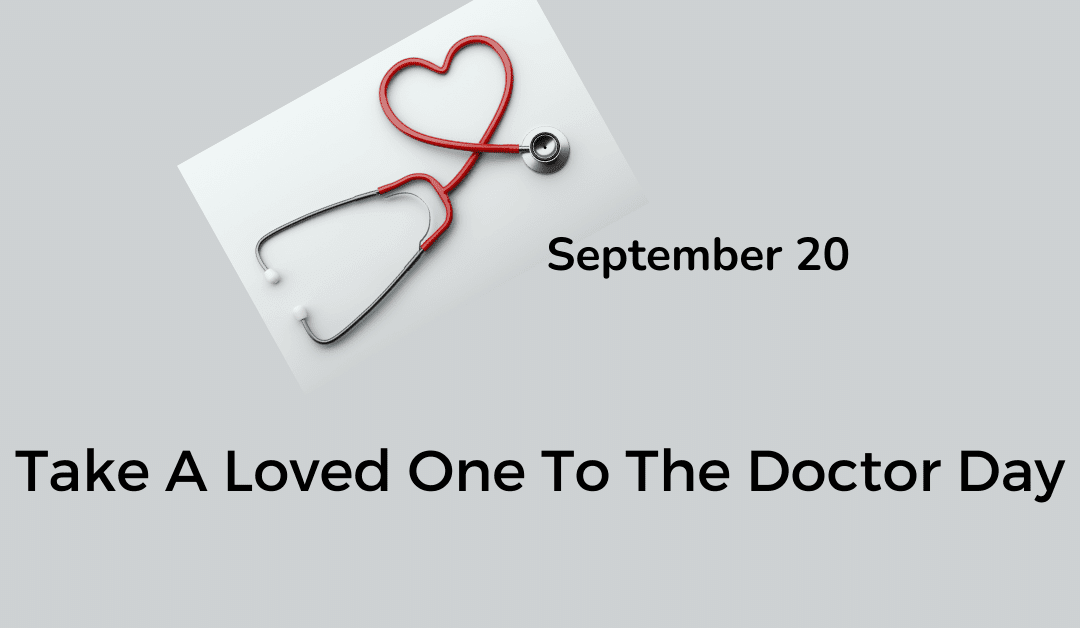
by Bag It Team | Aug 31, 2022 | Educational Articles
September 20 is Take a Loved One to the Doctor Day. It’s a day set aside to remind us that some of our loved ones may need a little help when it comes to seeing a healthcare provider. Many people skip regular check-ups or wait until there is an emergency to visit a doctor. This could put them at risk for serious health issues.
There can be many issues holding someone back from a visit to the doctor’s office. Fear of doctors, needles, or tests. Access or not having a general practitioner they know. Concern about insurance coverage or other costs. Not having the time or not being in the habit of regular check-ups. Whatever is holding them back, having some extra support and encouragement could help them to schedule a much-needed visit.
When starting the conversation make sure to ask your loved one about their current health needs and write down any concerns they have regarding a visit. It can be a delicate conversation but here are some resources to help guide you.
“Most people don’t bring up the idea of going to the doctor in regular conversation. Days like Take a Loved One to the Doctor offer the opportunity to have those discussions with someone who might be resistant to get a routine check-up.”
—Dr. Rupesh Parikh, Comprehensive Cancer Centers’ Practice President
Resources To Help Your Loved One
This AARP guide provides advice regarding how to talk to your loved one about going to the doctor, being prepared for your appointment and other useful resources. They recommend that “you might need to turn on your powers of persuasion to get your loved one to agree to see a doctor. Many people have a long list of reasons for avoiding doctors’ visits. Don’t fight every point.”
The Comprehensive Cancer Center recommends teamwork, incentives and setting up the appointment once they agree.
Once the appointment is made, the American Cancer Society has some great tips for before, during and after the visit.
The Bag It Guidebook includes forms for medications, insurance contacts, medical information, list of questions, and an appointment summary log to help you prepare for, interact during and summarize the appointments. If you don’t have a Bag It bag, you can download the forms from our website.
“Most people don’t bring up the idea of going to the doctor in regular conversation,” said Dr. Rupesh Parikh, Comprehensive Cancer Centers’ practice president. “Days like Take a Loved One to the Doctor Day offer the opportunity to have those discussions with someone who might be resistant to get a routine check-up.”

by Bag It Team | Aug 9, 2022 | Educational Articles
In recognition of National Wellness Month, we wanted to look at how we can all take some simple, purposeful steps to be more active, manage stress, improve our mental and physical health and more. Not just for the month of August but all year long.
Whether you want to focus on physical, emotional, spiritual, or social wellness, it is important to pick one thing and get started with small steps that will help your new healthy habits stick around for the long term.
Build Wellness Into Your Life
Making a plan sounds daunting but wellness goals should be simple, easy to adopt and fit into your lifestyle.
Here are a few examples of what your wellness plan might look like:
- I want to focus on being active. I am going to start sitting less every day by setting an alarm to remind me to get up and walk for 1 minute every hour. Tip: Set that alarm in another room so you have to get up to turn it off.
- I want to focus on self-care. I am going to start by taking a 15-minute break, in a quiet location, with a book and my coffee/tea/favorite beverage on Monday, Wednesday and Friday. Tip: Create a favorite space (inside or outside) that is only used for taking a moment out of your day to decompress.

- I want to focus on managing stress. I am going to incorporate a 4-4-4 breathing exercise at 10 a.m. and 2 p.m. for 1 minute (breathe in for a count of 4, hold for a count of 4 and exhale for a count of 4). Tip: Practice this technique at any point in your day you might need to manage stress (driving, during a work meeting, while having a difficult conversation).
- I want to focus on physical and mental health. I am going to practice yoga for 20 minutes 3 times this week. Tip: purchase an online plan or sign up for a class (committing money helps us also commit the time).
- I want to focus on healthy eating. I will incorporate 1 fruit or vegetable into at least 2 meals every day this week. Tip: Focus on what is in season so it will be tastiest and also give you variety throughout the year.
Looking for a little inspiration to get started?
Here are some other ideas to put you on the road to a healthier, happier life:
- Increase your water intake. The Mayo Clinic tells us how much water is enough.
 Monitor your sleep and make adjustments for better sleep habits.
Monitor your sleep and make adjustments for better sleep habits.- Join a walking, or aerobics class.
- Learn to meditate. Mindful.org gives you some meditation tips. \Plan a day of fun activities you love.
- Visit with friends and family.
- Start a gratitude journal. PositivePsychology.com can get your started.
- Practice being your own cheerleader with positive self-talk.
Setting Goals That Stick
We’re talking about wellness goals that are easy to incorporate into your lifestyle. But if you want some help with setting a goal, here are a few steps you can take to create a wellness plan that will endure:
- Pick a topic you want to focus on.
- Set 1 goal using the S.M.A.R.T. method
- Specific: The goal should be very precise with no room for misinterpretation.
- Measurable: The goal should be quantifiable, and progress should be easy to track.
- Achievable: The goal should be attainable — not outlandish or unrealistic.
- Relevant: The goal should contribute to your broader, overarching goals.
- Time-bound: The goal should have a defined start and end date.
- Share your goal with a trusted friend or family member. Accountability can often help encourage our success. You also might find a goal buddy!
- Write it down and put it somewhere you can see it every day.
Other Resources
Defining Wellness
The Global Wellness Institute defines wellness as the active pursuit of activities, choices and lifestyles that lead to a state of holistic health. – Read more about the Global Wellness Institute’s perspectives.
Wellness at Work
Since we spend much of our waking hours at work, here is a WebMD Health Services’ article that shows how to promote employee wellbeing.
Stay tuned for our August podcast for more on the five dimensions of wellness.
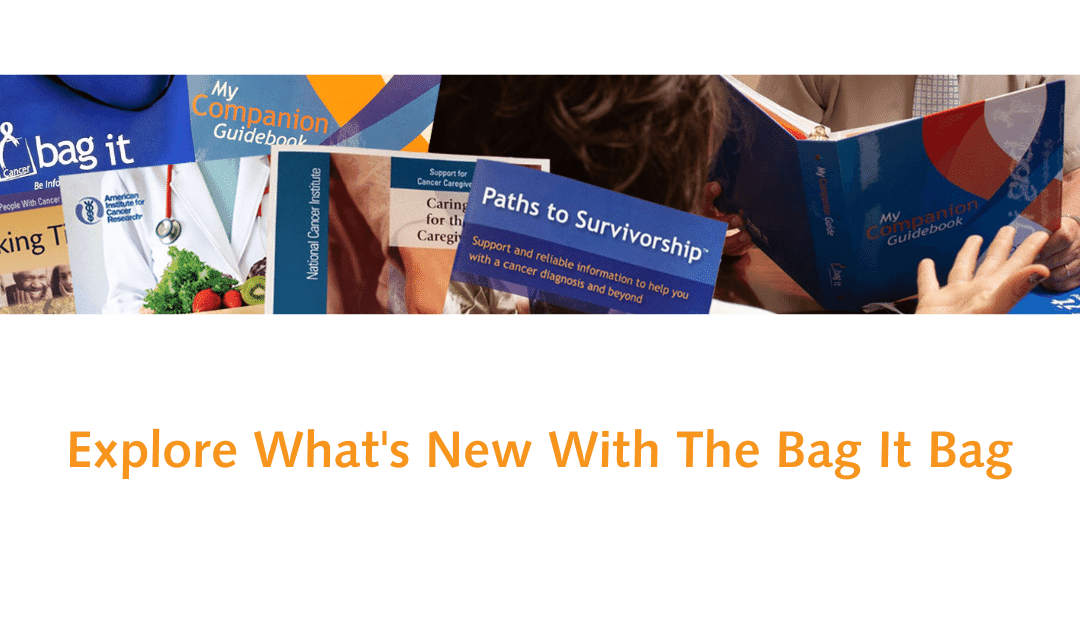
by Bag It Team | Jul 12, 2022 | Educational Articles
Every 18 to 24 months, we gather a committee of cancer survivors, care partners, oncology care providers, and nonprofit partners to conduct a review of the Bag It Bag. They assess how the current bag content and design are meeting the needs of people with cancer, their care partners, families, and the healthcare providers who care for them. The group also considers how the Bag could be improved.

The feedback we received from our recent review was thoughtful and insightful, as always. The consensus was that the significant revisions made to the Bag in 2019 continue to benefit the quality of the materials. Some helpful suggestions on ways to refresh and enhance some of the content were also offered.
The Covid-19 pandemic did not prevent us from completing this important process or continuing our work. For the Bag It Team, the challenges it brought reinforced that this valuable resource is critical for those dealing with cancer, renewing our commitment to our mission of educating, supporting, and empowering those impacted by cancer.
2022 Bag It Bag Updates
Paths to Survivorship Booklet
We added new information about dealing with potential cancer treatment side effects such as hot flashes, bone health, and genital and urinary problems, which are common for some types of cancer. It is important for people to understand all of their rights and options to best navigate their situations related to work, disability and health insurance, and managing finances. Triage Cancer provided valuable content on these legal and practical issues.
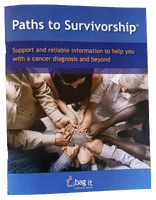 An overview about genetic and biomarker testing explains what they are and, when ordered by your doctor, how the test results can help your cancer care team offer you the most tailored options for effective treatment of your cancer. Your doctor will determine if this type of testing is appropriate for you.
An overview about genetic and biomarker testing explains what they are and, when ordered by your doctor, how the test results can help your cancer care team offer you the most tailored options for effective treatment of your cancer. Your doctor will determine if this type of testing is appropriate for you.
This booklet includes helpful lists of questions you can ask your healthcare team based on where you are in your diagnosis and treatment:
- Questions to ask your healthcare team about your diagnosis
- Questions to ask your healthcare team about cancer treatment
- Questions to ask your healthcare team about follow-up care
- Questions to ask your healthcare team about late and long-term side effects
- Questions to ask your healthcare team about living with chronic or advanced cancer
Here are printable versions of the questions to take with you to your appointments. You’ll also find other Self-Advocacy Tips and A Survivorship Checklist.
Paths to Survivorship (and all the booklets and forms in the bag) can be downloaded for free on our website. Want to share this great publication with others? You can email it in PDF format or send them the link to the Bag it Bag.
My Companion Guidebook
It goes without saying that there’s a lot of information coming your way when you or someone close to you is diagnosed with cancer. It can be overwhelming. A great deal of paperwork is given to you by your providers, and there is much to keep track of in an accurate and consistent manner.
 My Companion Guidebook is a helpful way to organize everything in one place to ensure you have access to what you need, when you need it. We’ve made some tweaks to make it easier to sort and store your records in the various sections, and added more tips on how to make the most of your appointments. There’s also a handy new page to keep a running list of your questions for your next doctor visit.
My Companion Guidebook is a helpful way to organize everything in one place to ensure you have access to what you need, when you need it. We’ve made some tweaks to make it easier to sort and store your records in the various sections, and added more tips on how to make the most of your appointments. There’s also a handy new page to keep a running list of your questions for your next doctor visit.
Blank copies of the forms to print or the fillable PDF format can be found on our Bag It Bag page.
Resources, Resources, and More Resources!
Did you know Bag It’s online Resource Center houses over 150 vetted websites covering a wide range of cancer topics? Whether you want education about your cancer type or to find support services out there that can help you or your family along the way, we’ve done the legwork to save you time and to bring you resources you can rely on.
At the same time, we also realize that not everyone has equal access to or is as comfortable using the internet. That’s why we added two new pages to My Companion Guidebook listing many helpful organizations to assist with some of the most common and pressing needs that cancer can bring. (Phone numbers are also listed in case you prefer to call and speak to someone there.)
Topics include:
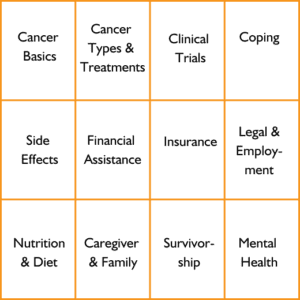
To order a Bag It Bag for yourself or someone else, visit our Bag It Bag order page.

by Bag It Team | Jun 14, 2022 | Educational Articles
Bag It Cancer continually reviews the Bag to ensure it is as helpful as it can be for those living with cancer. This spring we conducted research through a series of interviews and focus groups of Latino and Hispanic survivors, caregivers and other stakeholders for input on how to better address their values, beliefs, language, and culture in the Spanish Bag.
We heard about a variety of topics that would be beneficial to include in the Spanish Bag, or address in a different way in the Bag.

For example, to many people, cancer=death. If someone is diagnosed with cancer, the only possible outcome is death. We hope to dispel this commonly-held misconception and others by educating Bag users and families about the evidence-based facts about cancer. We gained more insight about the importance of family in the Latino and Hispanic communities. Family members often take part in the decision making about treatment. Their involvement in that process, and as caregivers, can have huge impacts on a patient’s wellbeing.
We also learned that if nutritional information in the Bag isn’t tailored to culturally relevant foods, patients and caregivers may not make necessary changes to their diet during and after treatment. We plan to include recipes from Latina kitchens that adapt favorite Latin dishes to make them healthier – lower in fat, richer in fiber and vitamins, but still tasty.
Latinos and Hispanics are disproportionately affected by poor conditions of daily life which are shaped by a variety of structural and social position factors (such as income, education, occupations, cultural values, and social support systems), known as social determinants of health. These factors impact their cancer care and survival. We can’t overcome all of these barriers, but we can do our small part by educating and guiding Latinos and Hispanics with a more culturally-tailored Bag It Bag.
We look forward to introducing the new bicultural Bag It Bag to you and your patients at the end of the year.
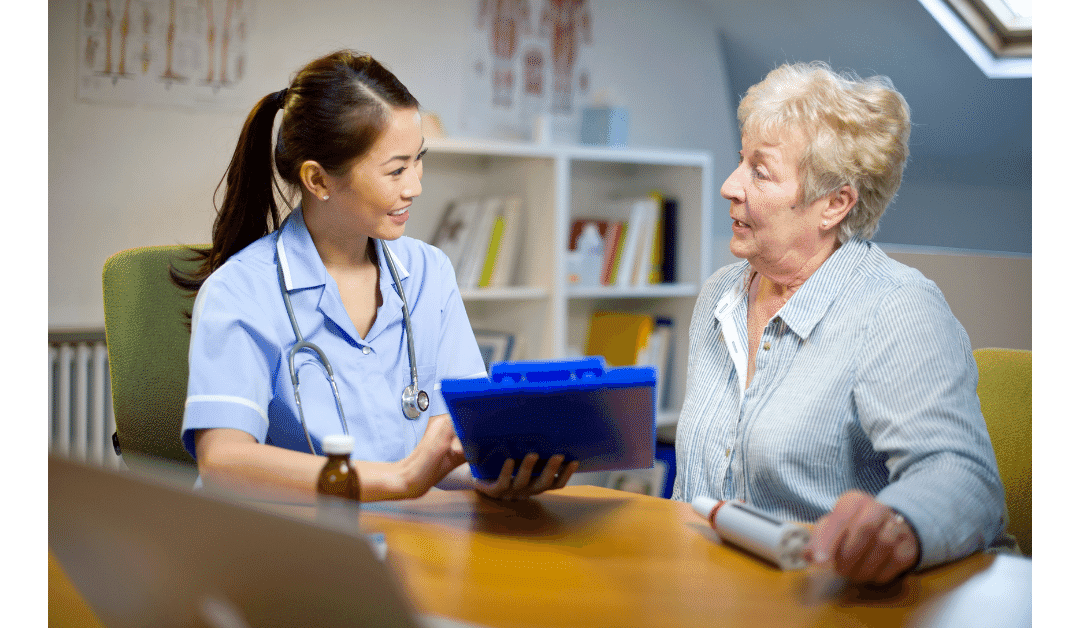
by Bag It Team | Jun 14, 2022 | Educational Articles
Every cancer patient deserves the best care possible. There isn’t a provider on the planet who disagrees with that. For many cancer centers and health systems, the best means putting together an all-star team capable of meeting the full needs of the patient, including “financial, psychological, social, logistical or related to communication.” That is why no oncology team is complete without an Oncology Nurse Navigator.
An Oncology Nurse Navigator is a clinically trained individual (typically a professional RN with oncology-specific clinical knowledge) who offers individualized assistance to patients and caregivers to help address barriers to timely and appropriate cancer treatment. They advocate for their patients throughout the cancer care continuum from diagnosis through survivorship and coordinate all components involved in cancer care, including surgical, medical, and radiation oncologists; social workers; patient education; community support; financial and insurance assistance; etc. They perform a vital role on the patient’s cancer care team.
Bringing on an Oncology Nurse Navigator is the first step. Equipping them with the best tools available is the second. That is why so many providers turn to Bag It Cancer. Oncology Nurse Navigators can assist patients with various issues beyond healthcare; comprehensive patient education tools like Bag It matter a lot in these situations. By providing a Bag It Bag, an Oncology Nurse Navigator can also help a patient learn to advocate for themselves and introduce them to reliable information that can often be difficult to find.
”When meeting patients for the first time, we often find the devastation of the new Cancer diagnosis to be overwhelming. They are not sure who to turn to, or where to begin. As certified Nurse Navigators, our first meeting is a cornerstone for care needs and coordination.
Having the Bag It Bag helps to introduce our ability to support and stabilize the care they need. At the same time, we use it to education them in essential ways. Lastly, it is a place to keep things from getting misplaced, and helps keep the Cancer ‘in its place’ in their lives from the start.”
Anyone that has ever met with an Oncology Nurse Navigator knows that support like patient education matters a lot and can be the difference between a good and bad experience for patients and caregivers.
So, if you don’t already have an Oncology Nurse Navigator on your team, or are interested in becoming a certified navigator, reach out to our friends at the Academy of Oncology Nurse & Patient Navigators (AONN).
If your practice needs to upgrade your patient education materials to match your new all-star team, please reach out at cj@bagitcancer.org and learn how Bag It can enhance your practice.

 October is Health Literacy Month. A study by Health & Human Services Office of the Surgeon General showed that only about 12% of Americans have proficient health literacy skills. Unfortunately, many adults lack good knowledge about their medical condition and treatment, and don’t know how to get information that is presented in a way they can understand. People report having difficulty completing medical forms and relaying important details to their doctor about their health. They may not be able to accurately read directions to take their medicines as prescribed. Each of these common situations can be linked to poor health outcomes.
October is Health Literacy Month. A study by Health & Human Services Office of the Surgeon General showed that only about 12% of Americans have proficient health literacy skills. Unfortunately, many adults lack good knowledge about their medical condition and treatment, and don’t know how to get information that is presented in a way they can understand. People report having difficulty completing medical forms and relaying important details to their doctor about their health. They may not be able to accurately read directions to take their medicines as prescribed. Each of these common situations can be linked to poor health outcomes.




 Monitor your sleep and make adjustments for better sleep habits.
Monitor your sleep and make adjustments for better sleep habits.

 An overview about genetic and biomarker testing explains what they are and, when ordered by your doctor, how the test results can help your cancer care team offer you the most tailored options for effective treatment of your cancer. Your doctor will determine if this type of testing is appropriate for you.
An overview about genetic and biomarker testing explains what they are and, when ordered by your doctor, how the test results can help your cancer care team offer you the most tailored options for effective treatment of your cancer. Your doctor will determine if this type of testing is appropriate for you. My Companion Guidebook
My Companion Guidebook



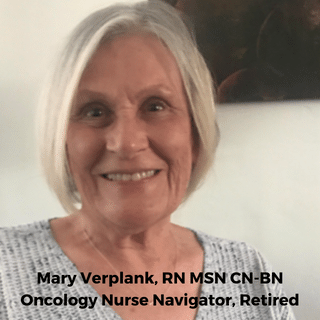
Recent Comments